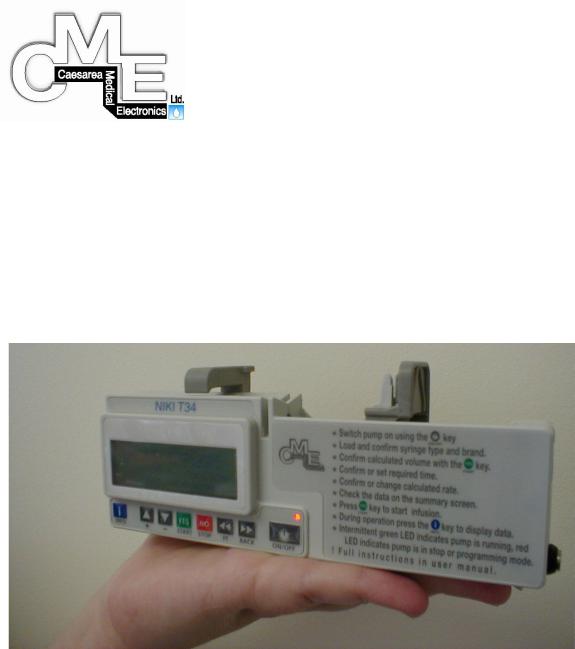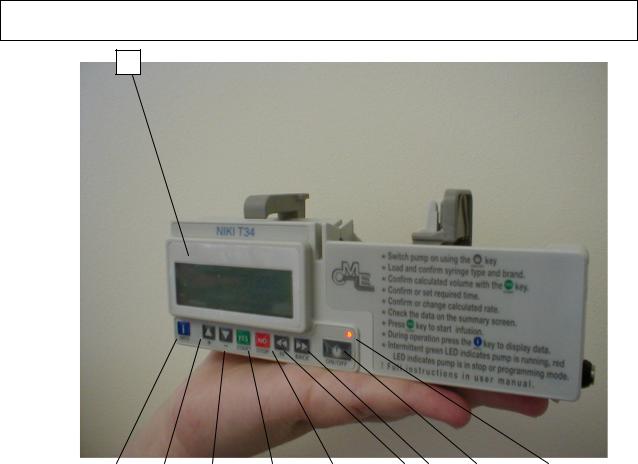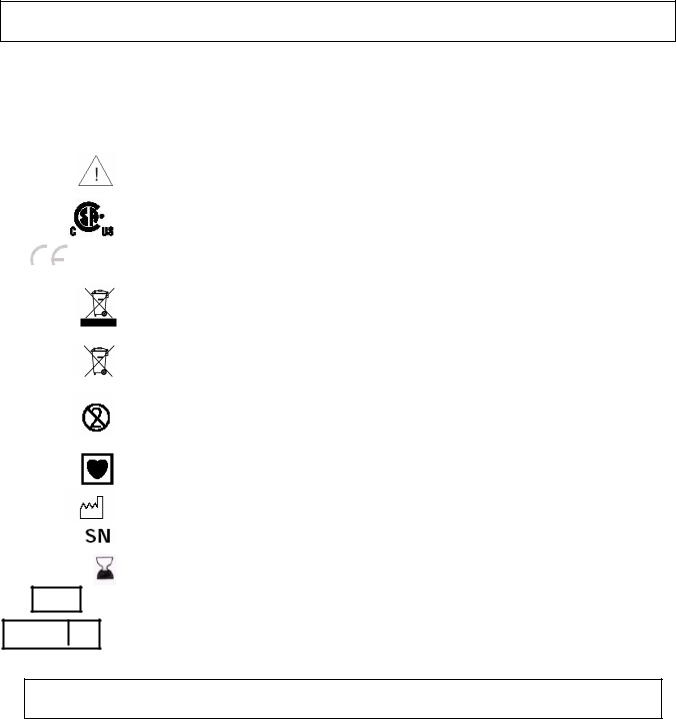CME Niki T-34 User manual

NIKI T34 SYRINGE PUMP
Instruction Manual
Ref.: 100-090SS Edition June 2008
 0473
0473
2 |
|
CONTENTS |
|
A - Introduction |
3 |
B - General Warnings |
5 |
C – Precautions |
6 |
D – Feature Recognition |
7 |
E – Symbols on pump, consumables & accessories |
8 |
F - Installation and Inspection |
8 |
G - Administration Sets |
9 |
H – Batteries |
10 |
I – Access Codes & Keypad Lock |
11 |
J – Infusion set up & programming |
12 |
K – Using Accessories with T34 Syringe Pump |
16 |
L – Recommended Checks during infusion |
17 |
M – Advanced Functions of the T34 |
18 |
N - Change Set Up |
19 |
O– Alarm Conditions |
20 |
P – Troubleshooting |
21 |
Q – Specifications |
22 |
R – Patient Training – Using the T34 |
23 |
S – Service, Calibration and Maintenance |
24 |
T - LIMITED WARRANTY |
25 |
U - APPENDIX |
26 |

3
A - Introduction
Do not operate the T34 Syringe Pump until you have read and understood the contents of this manual paying close attention to Warnings, Cautions & Notes as described below. If you are unsure about any aspect contact the distributor or manufacturer.
This manual will ensure the Healthcare Provider will be able to: -
1.Identify the features of the T34 and understand their use
2.Correctly load a syringe into the T34
3.Program the T34 to deliver the contents of the syringe
4.Access and interpret patient history and event log data
5.Troubleshoot and resolve alarm conditions
6.Train patients and/or patient’s caregiver in the use of the T34.
What is the T34 Syringe Pump?
The T34 is a small, lightweight, robust, battery powered, ambulatory syringe Pump designed to deliver the contents of a 2 to 50ml syringe over a specified duration or at a given rate in milliliters per hour (ml/hr). The Pump actuator drives the syringe plunger forward at a controlled rate. This rate is adjustable from 0.1 to 1000 ml/h in increments of 0.1 ml/h up to 100 ml and 1 ml up to 1000 ml/h.
The size and weight of the T34 makes it ideal for ambulatory use in a hospital or alternate site / homecare setting. It is equally suitable for adults or for pediatric use.
The T34 syringe pump can be easily concealed beneath clothing in a shoulder holster and combination belt. A compact lockbox is provided to protect the Pump from damage and/or tampering with either the pump or the syringe.
T34 offers 3 point syringe detection enabling the pump to identify all commonly used (or programmed) syringe brands. This feature ensures the pump can make calculations for the healthcare provider therefore minimizing the risk of programming errors. The sensors also activate an alarm if the syringe is removed or partially displaced during infusion.
The T34 syringe pump may be used to deliver indicated medications via any common infusion routes including central, peripheral venous, epidural, intra-arterial or subcutaneous.
Indications for Use
The T34 SYRINGE DRIVER is designed for infusion of medications or fluids requiring continuous or intermittent delivery at precisely controlled infusion rates through all clinically acceptable routes of administration including intravenous, subcutaneous, percutaneous, intraarterial, epidural, enteral, in close proximity to nerves, and into an intraoperative site (soft tissue/body cavity/surgical wound site). The system is intended for patients who require maintenance medications, analgesics, PCA therapy, parenteral and enteral nutrition fluids, chemotherapeutic agents and general fluids therapy in hospital and homecare environments.
4
Contraindications
•Infusion of blood and blood products.
•Infusion of insulin.
•Infusion of critical medications whose stoppage or interruption could cause serious injury or death.
•Use in ambulatory regimens by patients who do not possess the mental, physical or emotional capability to self-administer their therapy; or who are not under the care of a responsible individual.
Pump Lockout Protection Features
The T34 has several lockout features that ensure that unintended programming and key
presses do not occur.
The T34 syringe is contained within a locked box. Only the healthcare provider is able to open the box.
After the healthcare provider programs the T34 for infusion, they will lock the program with a special code. The T34 infusion program cannot be changed unless the healthcare provider re-enters the code and changes the program.
The keypad has a locking feature that prevents unintentional power off of the unit. This lock is available to the patient.
Service screens and troubleshooting are protected with a technician’s code. These codes are only available to personnel trained in servicing the T34.

5
B - General Warnings
To reduce potential risks to patients and healthcare providers.
The T34 is a medical device designed for the safe, accurate delivery of appropriate infusion regimes and should only be operated by, or under the supervision of, a medical/healthcare professional.
 For pumps used in a home setting, once the prescription has been programmed into the pump, lock the system to ensure that the program cannot be changed by the patient.
For pumps used in a home setting, once the prescription has been programmed into the pump, lock the system to ensure that the program cannot be changed by the patient.
 The equipment is not suitable for use in the presence of flammable anesthetic gas /oxygen/nitrous oxide mixture. Do not use the system in environments where these agents are present.
The equipment is not suitable for use in the presence of flammable anesthetic gas /oxygen/nitrous oxide mixture. Do not use the system in environments where these agents are present.
 Do not use the T34 pump in the presence of high-intensity magnetic fields (e.g., MRI scanners). Exposure to strong magnetic fields may impair the operation of the pump and/or the accuracy of the infusion.
Do not use the T34 pump in the presence of high-intensity magnetic fields (e.g., MRI scanners). Exposure to strong magnetic fields may impair the operation of the pump and/or the accuracy of the infusion.
 Never take a syringe that is not empty off the pump if it is still connected to the patient. Before removing the syringe, the infusion line must be disconnected or clamped to prevent free flow. Depending on the medication and route of administration, free flow into the patient may cause serious injury or death.
Never take a syringe that is not empty off the pump if it is still connected to the patient. Before removing the syringe, the infusion line must be disconnected or clamped to prevent free flow. Depending on the medication and route of administration, free flow into the patient may cause serious injury or death.
 Before connecting to the patient, purge all air from the syringe and the administration set. Depending on the route of administration and the volume of air, air emboli infused into the patient may cause serious injury or death.
Before connecting to the patient, purge all air from the syringe and the administration set. Depending on the route of administration and the volume of air, air emboli infused into the patient may cause serious injury or death.
 Patients using the T34 Syringe Pump on their own, or individuals responsible for helping a patient using the pump, must be instructed in its proper use.
Patients using the T34 Syringe Pump on their own, or individuals responsible for helping a patient using the pump, must be instructed in its proper use.
 Adjustments, maintenance, or repair made by un-certified service personnel may impair the operation of the T34 System and/or the accuracy of the infusion. Make sure any adjustments, maintenance, or repair of the device is carried out by authorized skilled technicians trained by the T34 distributor.
Adjustments, maintenance, or repair made by un-certified service personnel may impair the operation of the T34 System and/or the accuracy of the infusion. Make sure any adjustments, maintenance, or repair of the device is carried out by authorized skilled technicians trained by the T34 distributor.
 Dropping the Syringe Pump could cause damage to components. If the pump is dropped, return the pump for inspection by qualified service personnel.
Dropping the Syringe Pump could cause damage to components. If the pump is dropped, return the pump for inspection by qualified service personnel.
 Use good aseptic technique when filling the syringe and priming the infusion set. Patient infection may result from the use of non-sterile components. Maintain sterility of all disposable components and do not re-use single use IV sets.
Use good aseptic technique when filling the syringe and priming the infusion set. Patient infection may result from the use of non-sterile components. Maintain sterility of all disposable components and do not re-use single use IV sets.
 Immersing the T34 Syringe pump in liquid could cause damage to components. Do not immerse the pump into any type of liquid.
Immersing the T34 Syringe pump in liquid could cause damage to components. Do not immerse the pump into any type of liquid.
 Caution: Federal [USA] Law restricts this device to sale by, or on the order of, a physician.
Caution: Federal [USA] Law restricts this device to sale by, or on the order of, a physician.

6
C – Precautions
Information to ensure safe and effective use.
Before use, the user must become thoroughly familiar with the operating instructions contained in the T34 user manual.
The provider is responsible for ensuring that the T34 pump and medications are used according to the physician’s infusion therapy prescription.
The provider is responsible for educating the patient in proper use of the pump.
Do not allow water or other fluids to get inside the pump or the lockbox. Fluids getting into the pump may damage it. If the pump gets wet, stop the pump and initiate service of the pump.
A security code must be keyed in to access the lock-level 2 programming functions. This code is designed to allow access to the provider only. To prevent a patient from tampering with programmed settings, this security code should not be given to the patient.
As with any infusion, the disposables used with the T34 pump must be compatible with the medication being delivered. Check with the manufacturer of the disposables before use. Consult the drug manufacturer’s insert for precautions, guidelines, and instructions for preparing and using the medication.
Do not drop the pump, strike it against hard objects or otherwise subject it to extreme physical stress. This could damage the pump, which may impair the operation of the pump and/or the accuracy of the infusion. If the pump is dropped, return the pump for inspection by qualified service personnel.
Unsafe operation may result from using improper accessories. Use only accessories and options designed for this system and supplied by the T34 distributor.
A kinked/occluded infusion line may impair the operation and accuracy of the pump. Before operation, verify that the infusion line is not kinked or occluded.
Make sure any adjustments, maintenance or repair of the device are carried out by authorized service technicians certified by the T34 distributor. Adjustments, maintenance or repair made by un-qualified service personnel may impair the operation of the pump and/or the accuracy of the infusion.
Battery damage could occur at ambient temperatures >55°C (131°F).
To prevent damage to the pump, do not store the pump for extended periods with the battery in the pump.
The pump housing is not hermetically sealed – immersing the pump in liquid could cause damage internal components. Do not immerse the pump into any type of liquid.
If fluid is spilled on the pump, clean and dry it immediately. A damp cloth should be used for cleaning and a mild detergent may be used if needed. Xylene, acetone or similar solvents could damage the pump – do not clean the pump with harsh chemicals.

7
D – Feature Recognition
1
8 |
|
7 |
|
6 |
|
5 |
|
4 |
|
10 |
|
9 |
|
3 |
|
2 |
|
|
|
|
|
|
|
|
|
|
|
|
|
|
|
|
|
1Pump display - Backlight can be enabled when any key pressed
2Operation LED -
a. Green shows infusing b.Red when Stop or alarm
3ON/OFF key - Switches the pump on and off.
4NO/STOP key –
a.Takes user back a step
b.stops pump
5 |
YES/START key – |
Confirms choices |
6 |
Down arrow key - |
scrolls between options |
7Up arrow key – Scrolls between options
8Info key -
a.shows technical data and Battery status
b.Long press will Lock/Unlock Keypad
9 Forward key.
10 Backward key.

8
E – Symbols on pump, consumables & accessories
System Symbols
The following symbols are used on the Caesarea Medical Electronics Ltd. T34 Syringe Pump and components. Labels on the pump or statements in this manual preceded by any of the following words and/or symbols are of special significance and/or are intended to help you to operate the pump in a safe and successful manner.
Attention, consult accompanying Instructions.
CSA mark




 0473
0473
LOT
STERILE EO
CE mark indicates conformance to Medical Device Directive 93/42/EEC.
Do not dispose of in municipal waste. Symbol indicates separate collection for electronic equipment. (WEEE Directive 2002/96/EEC). NOTE: Does not apply to the battery.
Do not dispose of battery in municipal waste. Symbol indicates separate collection for battery is required.
The use of single-use disposable components on more than one patient is a biological hazard. Do not reuse single-use disposable components.
Type CF applied part.
Date of Manufacture
Serial Number
Expiry Date (consumables)
Lot Number (consumables)
Sterilized with Ethylene Oxide
F - Installation and Inspection
Unpacking
1.Remove the T34 Syringe Pump & accessories from the box and inspect for damage during shipment or storage.
Do not use T34 if there are any obvious signs of damage. Return for inspection by authorized service personnel.
2.Make sure you have the following items:
•T34 Syringe Pump
•Patient Guide
•Alkaline 9V batteries
•Carry Pouch
•Lockbox
If any items are missing or damaged, contact your supplies department to order replacement.
